$6.5 Million in Streetcar Savings
Agreement with We Energies reduces utility relocation costs.
Following over a year of negotiations with We Energies regarding utility relocation, the city and company have reached an agreement that includes $6.5 million in savings on the Milwaukee Streetcar project. We Energies has submitted an agreement to relocate all of their affected steam, gas and electric lines at a cost of $15 million. The city had originally budgeted $21.5 million for this work.
Will that result in a $6.5 million reduction in the city’s costs for the project? It’s “too early to say” according to Ashley Booth, planning and technical services director at HNTB. While the savings are “obviously a positive advancement” for the project, Booth said during a meeting of the Joint Committee on Downtown Streetcar Implementation, there are a lot of moving parts that could change things for a project up to three years from completion. HNTB is leading engineering work on the project for the city.
The agreement with We Energies only includes the first phase of the streetcar project, a 2.1 mile route that runs from the Milwaukee Intermodal Station to the Lower East Side. Relocation costs on the approved lakefont spur will have to wait, as the city is only at 30 percent engineering completion on that line. The budget for the lakefront spur is set at $29.2 million, including utility relocation. Utility costs are expected to be substantially less for the lakefront line due to the lack of current development in that area and the north-south alignment of the We Energies steam system.
The city intends to sign the agreement with We Energies in the coming weeks. Further agreements will be needed with additional private utilities, including AT&T, following route adjustments prior to the project’s final approval. Those costs are estimated at less than $2 million and are included in the existing project budget. In addition, work is substantially complete on the relocation of city-owned Milwaukee Water Works lines. That work is coming in at budget at a cost of approximately $1 million.
Should the savings ultimately materialize, the city would be the beneficiary. The federal government’s share of the first phase of the project is firmly committed at $54.9 million, with $14.2 million coming from an additional grant for the lakefront spur. The federal grant for the lakefront spur increased the project budget, as the city had conservatively estimated to only receive $10 million from Washington.
Through January, approximately $10 million out of the $128.1 million project budget has been spent.
Utility Lawsuit Impact
Seeking clarification around what he characterized as “lying”by others on the matter, alderman Robert Bauman asked Booth about any increase in project cost relating to the recent court ruling that the city is liable for any private utility relocation costs. Booth, ever cautious, wouldn’t say that others are “lying” but did say there was an impact of “zero dollars” on the project budget. Bauman was clearly referencing alderman and mayoral candidate Bob Donovan, who had claimed the ruling would increase costs. For more on this issue and the associated lawsuit, see my February 15th column.
Last News Before the Election
In a clever twist, the streetcar task force won’t meet again until after the April 5th election. The next regularly scheduled meeting of the Joint Committee on Downtown Streetcar Implementation was to be in two weeks, and the only big news expected by then is the notice that the city is soliciting bids on construction work. That means Mayor Tom Barrett‘s last major announcement regarding the Milwaukee Streetcar project will be a $6.5 million savings in private utility relocation.
Streetcar Renderings
Route Maps
Project Budget
Capital Costs
- Maintenance facility: $7.5 million
- 4 Vehicles: $17.6 million
- Phase 1 route: $73.8 million
- Phase 2 route (Lakefront extension): $29.2 million
Funding Sources
- Federal ISTEA funding : $54.9 million
- Federal TIGER grant: $14.2 million
- Cathedral Place #49 TIF: $9.7 million
- Erie/Jefferson Riverwalk TIF #56: $18.3 million
- East Michigan St. TIF #82: $31.0 million
Operations
A federal congestion mitigation and air quality grant will pay for 80 percent of the operating costs for the first 18 months, with a possible 18-month extension. Operating costs will be covered by farebox revenue, advertising, corporate sponsors and the parking fund. Operating costs are estimated at $2.65 million annually. Service on the first phase of the system is on-track to begin in early 2018.
More about the Milwaukee Streetcar
For more project details, including the project timeline, financing, route and possible extensions, see our extensive past coverage.
- Another Streetcar Collision - Jeramey Jannene - Jun 27th, 2025
- Streetcar Hit By Apparent Red Light Runner - Jeramey Jannene - Jun 16th, 2025
- Streetcar Will Run On Consolidated Route During Summerfest - Jeramey Jannene - Jun 11th, 2025
- City Hall: Milwaukee Must Replace Failing Streetcar Switches - Jeramey Jannene - Feb 24th, 2025
- Streetcar Confronts Limited Funding, Operations Challenges - Evan Casey - Jan 22nd, 2025
- Council Kills Streetcar’s ‘Festivals Line’ - Jeramey Jannene - Jul 31st, 2024
- Streetcar Will Use Festivals-Oriented Route Through Summer - Jeramey Jannene - Jul 9th, 2024
- The Hop’s Lines Will Merge For Easier Summerfest Service - Jeramey Jannene - May 30th, 2024
- Streetcar Begins Daily Service To The Couture, BRT Will Soon Follow - Jeramey Jannene - Apr 11th, 2024
- Milwaukee’s Three Streetcar Extensions Need Mayoral Direction - Jeramey Jannene - Nov 8th, 2023
Read more about Milwaukee Streetcar here
Political Contributions Tracker
Displaying political contributions between people mentioned in this story. Learn more.
- November 13, 2017 - Tom Barrett received $400 from Ashley Booth
- March 22, 2017 - Robert Bauman received $50 from Ashley Booth
- May 19, 2016 - Robert Bauman received $100 from Ashley Booth
- October 14, 2015 - Tom Barrett received $400 from Ashley Booth
- April 14, 2015 - Robert Bauman received $100 from Ashley Booth
- September 10, 2014 - Robert Bauman received $50 from Ashley Booth
Eyes on Milwaukee
-
Church, Cupid Partner On Affordable Housing
 Dec 4th, 2023 by Jeramey Jannene
Dec 4th, 2023 by Jeramey Jannene
-
Downtown Building Sells For Nearly Twice Its Assessed Value
 Nov 12th, 2023 by Jeramey Jannene
Nov 12th, 2023 by Jeramey Jannene
-
Immigration Office Moving To 310W Building
 Oct 25th, 2023 by Jeramey Jannene
Oct 25th, 2023 by Jeramey Jannene
Transportation
-
MCTS Adds 28 New Buses
 Jul 13th, 2024 by Graham Kilmer
Jul 13th, 2024 by Graham Kilmer
-
MCTS Designing New Bus Shelters
 Jul 10th, 2024 by Graham Kilmer
Jul 10th, 2024 by Graham Kilmer
-
MCTS Updates RNC Bus Detours To Better Serve Downtown, Riders
 Jul 9th, 2024 by Jeramey Jannene
Jul 9th, 2024 by Jeramey Jannene


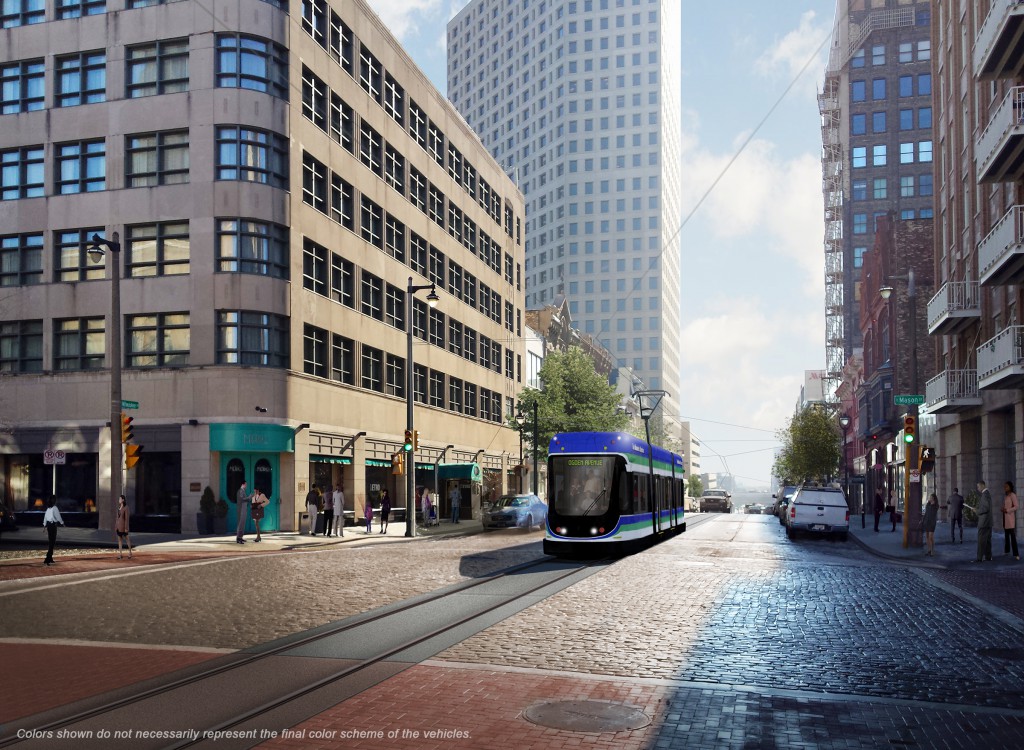
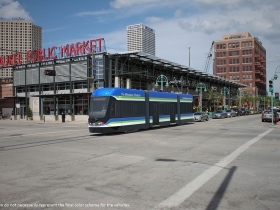
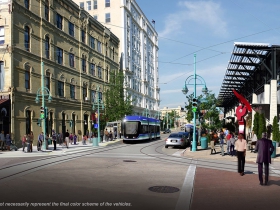
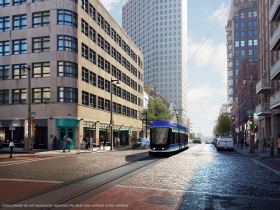
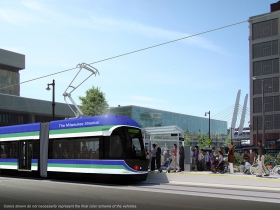
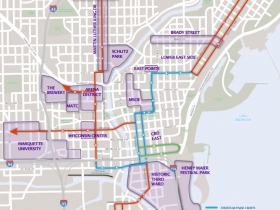
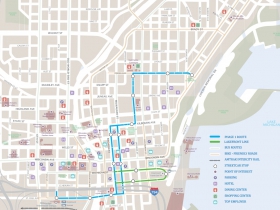
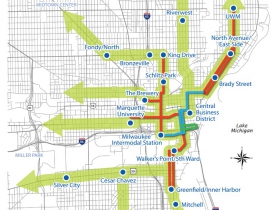




















This cost reduction is great news, but I’d like to see that money used to extend the tracks just two blocks (to 4th and Wisconsin)—making the streetcar much more useful and successful.
The City’s long-term plan is to extend streetcar service north along 4th Street as funds become available. But for now, the last stop will be on St Paul at 4th Street (near the Intermodal Station), although the tracks continue beyond—north to the streetcar’s garage at 4th and Clybourn.
If the tracks extended just two more blocks (ending on 4th south of Wisconsin) and one more station built (named “Grand Avenue” or “Convention Center”), the streetcar would directly serve the Convention Center and Grand Avenue. It would be within walking distance of the Arena, Bradley Center, Library, Public Museum, and at least 6 more hotels (including the Hilton, Downtown’s largest).
Last, but not least, it would make much better bus connections with MCTS at 4th and Wisconsin.
All that’s needed is one additional station and a quarter-mile of single-track (roughly the cost of an eighth-mile of double-track)—infrastructure that’s already planned for later. I’m just asking that it be built now instead of, say, 2021.
These are thoughtful suggestions, Tom D. My fear has been that this will be a “white elephant” for issues of practicality and service levels (wait times, locations, etc). So the points in your commentary might mitigate against that happening.
One reservation I have, though, is that in a budget of this size $6.5 million is a modest cushion against cost overruns. In my experience virtually any project (even a home remodel, for example) runs into unforeseen expenses no matter how carefully planned. And for public sector projects, my usual private sector hedge (“add 20%+ for contingencies”) often would be too conservative. Seems they always creep, and sometimes “skyrocket” as the work progresses and passes the point of no return, which will come quickly in this instance, I imagine.
Another consideration is the number of streetcar vehicles, which I suppose translates into frequency of stops at stations. Whenever interval times get longer, the number of passengers willing to wait (versus walking or cabbing, etc) goes down. Wouldn’t adding distance either require another car be purchased or else stretch out the intervals between stops? Moreover, with the advent of Uber service, the cost of alternative transportation has gone down, and I wonder if that has been factored into the projected ridership.
I hardly ever take a cab myself in Milwaukee, but the younger generation and my condo neighbors are frequent Uber users, and I’m not sure that will change given that multiple people can hop in a cab door-to-door at a moment’s notice or at a planned time, rather than each paying for bus or rail along with experiencing the inevitable wait.
Off the topic, I guess, but I still have trouble justifying Federal funding for a project that is VERY local in its impact, and not even widespread in terms of how many “locals” will benefit. Personal opinion: It’s not like the US Government is so awash in revenue that it should be granting money here there and everywhere. But that’s a subject larger than this one streetcar project and relates to differing political and economic philosophies. Every time I think of the Milwaukee streetcar, I inevitably imagine the logical reaction of some taxpayer in Podunk, Missouri to this kind of spending. Or, closer to home, the family living on the Northwest side of Milwaukee and trying to make ends meet.
You suggest adding “20% for contingencies”. The streetcar budget comes close to that—adding about 15% of projected construction and vehicle acquisition costs for “unallocated contingencies” plus another 4% of those costs for inflation (which they call “escalation”). These reserves have been “baked into” the budget from day one and have always been included in the announced project cost.
See the 2nd-last page of this document for an example:
http://milwaukeestreetcar.com/pdf/Milwaukee-Streetcar-Environmental-Assessment.pdf
The newly-saved $6.5 million is in addition to those reserves.
The “inevitable” waits for a streetcar aren’t as long as you might think. The plan is to provide a streetcar every 10 minutes most of the time (7 am to 10 pm weekdays) and every 15 minutes at other times. When there is a streetcar every 10 minutes, the average wait is just 5 minutes (sometimes you wait longer than 5 minutes, but just as often your wait is shorter). Even after 10 pm or on weekends, when streetcars only run every 15 minutes, the average wait will be 7.5 minutes. I suspect that’s still competitive with Uber. The streetcar’s $1 fare is far cheaper than Uber (even without Uber’s “surge pricing”).
And, just like Uber, you always know how long you must wait. Every streetcar stop will have an LED “count-down” clock showing the real-time wait for the next streetcar (e.g. “Next car arrives in 5 minutes”). The signs will be continuously updated from GPS data transmitted from each streetcar. All these costs have been included from day one (and is one reason the streetcar costs more than bare-bones MCTS bus service).
You are correct that adding another 3 blocks to the route (2 blocks of new track plus a third block which is slated to have track but no passengers) increases the route length and duration by about 20%. If nothing else changed, that would increase vehicle spacing from the planned 10/15 minutes to 12/18 minutes. Putting another vehicle on the road to maintain 10-minute frequency (actually, cutting the intervals to 9 minutes) would be quite expensive—over $4 million upfront to buy another vehicle plus an increase in operating cost. I have no magic solution for this.
As to whether this is an appropriate federal expense, remember that every transit project has two cost components: capital and operations, and the capital is, over time, the lower of the two. In general, Washington only subsidizes CAPITAL expenses and then picks up, at most, 80 cents of each dollar. This is lower than the 90% Washington pays for local highway projects like the Marquette Interchange or the Hoan; yes, I know they are “interstates” but 99% of their traffic has Wisconsin plates or was rented in Wisconsin (most of Mitchell’s rental-car fleet has out-of-state plates).
To see how operating expenses dwarf capital costs, consider a typical MCTS bus. Each costs about $400,000 which comes to $25,000 to $40,000 annually over a 10-to-16-year lifespan. But MCTS spends $300,0000-to-$400,000/year operating that bus, and those operating costs are almost never subsidized by Washington.
Compared to buses, streetcars cost more upfront, but then cost less (per passenger) to operate and have a vehicle lifespan about 6X longer than a bus. Streetcars also have no tailpipe pollution, are quiet, and ride much smoother than buses or Uber. (Why do you think Milwaukee-Chicago travelers overwhelmingly choose Amtrak over Greyhound or Megabus—even though the bus is much cheaper and runs more frequently?) A train’s smoother ride attracts more passengers than a bus which results in more fare revenue fewer and cars on the road.
Tom D,
Appreciate all the information. I will probably continue with my doubts until we see how this whole thing plays out.
Found this very recent link about the Atlanta situation, which is a bit unsettling. Do you know what they’ve done wrong that Milwaukee won’t fall into?
http://m.wsbtv.com/news/news/local/streetcar-ridership-drops-significantly-new-fare/nqRDW/
Tom D., I completely agree with your suggestion about running the initial streetcar route to 4th& Wisconsin. As is, it bypasses an area that much needs a lift. As you note, it would also connect it to the MCTS stops on Wisconsin Avenue, convention center, attractions, hotels, etc., and connect those areas with Third Ward, East Town and Lakefront.
Even though the walk to the Intermodal Station is only two blocks away, it’s currently not an enticing route, with little happening along the way. If the pilot route ignores Westown, the launch risks being experienced as “elitist.” a charge already being lobbed. If it’s not viewed as practical enough, it will be harder to win sufficient riders and public support for timely expansions.
You seem to know a lot about the project. Might there be any hope for this?
http://www.themilwaukeestreetcar.com/route.php
Virginia Small, all I know about the streetcar is what I read on the web. I have built a small library of downloaded documents over the last few years which I reference as needed.
For example, while Milwaukee was soliciting bids for streetcar vehicles, its online RFP documents contained tons of information about vehicles (e.g. each vehicle must be powerful enough to push or tow a second disabled streetcar back to the garage) and tracks (very detailed route maps).
Billy J, I don’t know anything about Atlanta or its streetcar, so I’m in no position to say how it relates to Milwaukee. I do know that similar new streetcars in Portland, Seattle, and Tucson have done well.